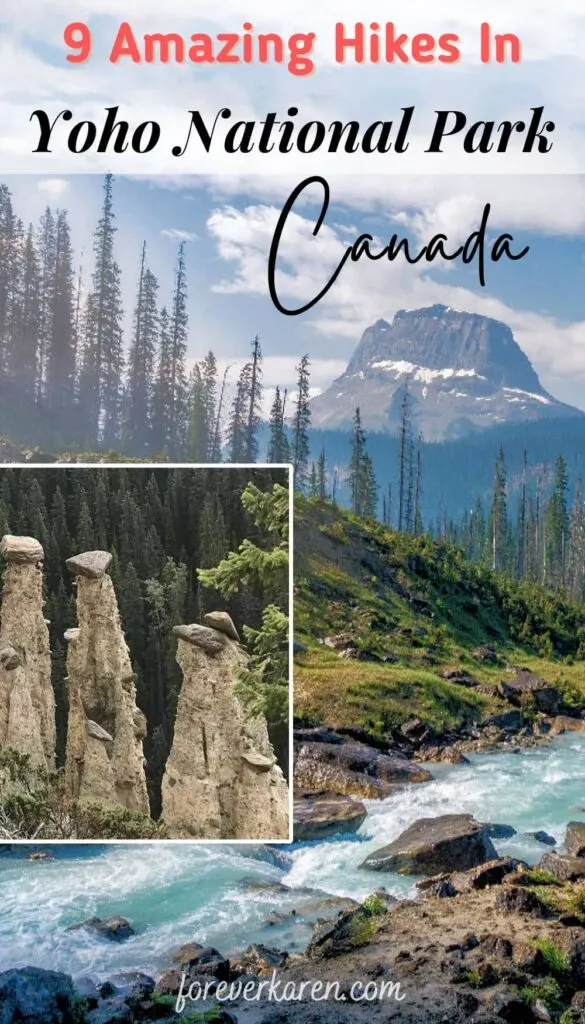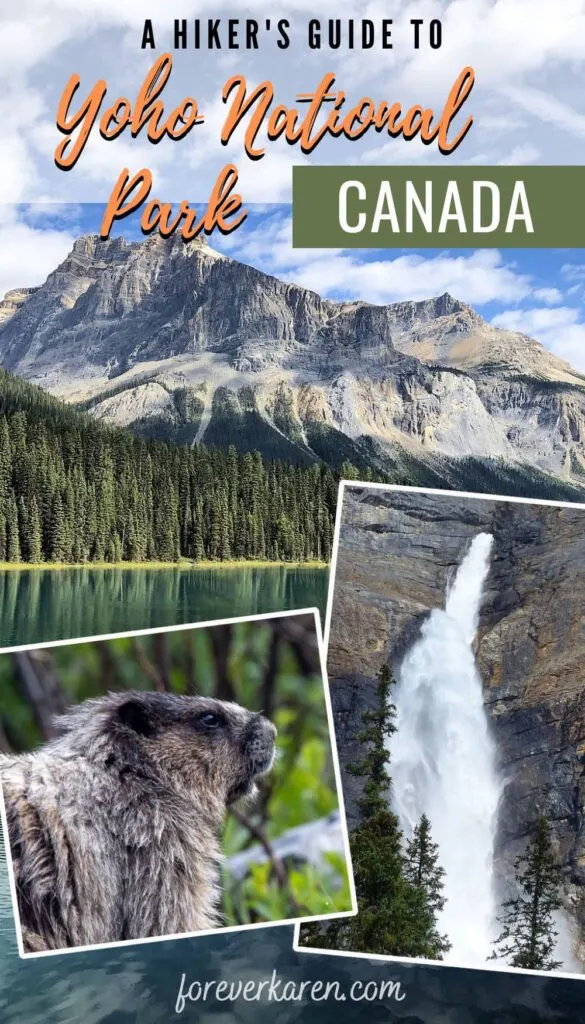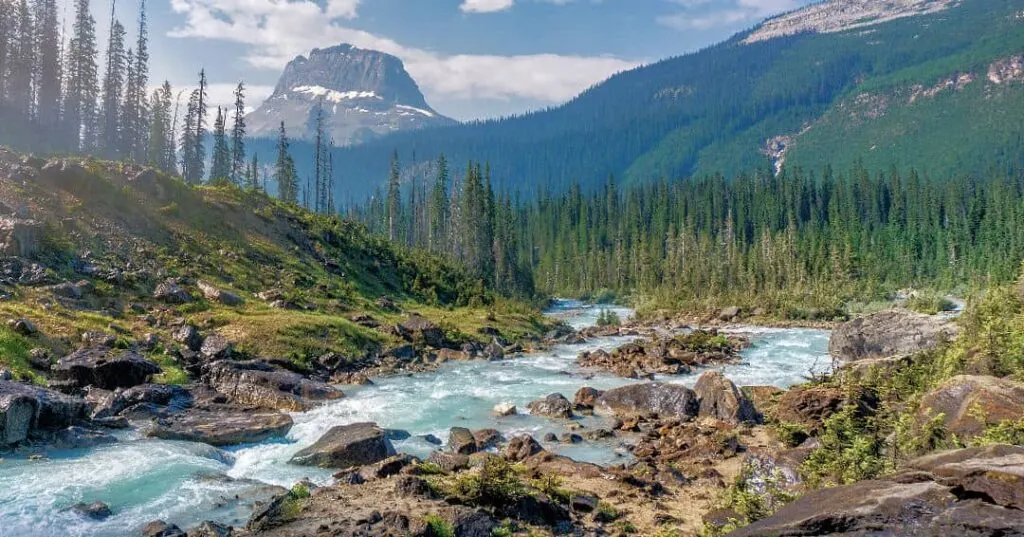
When travelers think of the Canadian Rocky Mountains, Banff, Moraine Lake, and Lake Louise come to mind. But the mountains offer more than one park. Yoho National Park bordering the more prominent and more popular Banff is just as picturesque with fewer tourists.
With jaw-dropping attractions like Lake O’Hara, Emerald Lake, and Takakkaw Falls, Yoho National Park entices visitors to hike its backcountry.
As part of the Canadian Rockies, Yoho National Park offers fantastic day hikes to see stunning waterfalls, lakes, and other natural landscapes. These nine day hikes in Yoho are rated easy to moderate and offer the best scenery, comparable to what you’d see in Banff.
Where Is Yoho National Park?
- Location: British Columbia, 28 km from Lake Louise
While Banff lies in Alberta, Yoho lies on the western side of the Continental Divide, in British Columbia. The UNESCO World Heritage site has 1313 square km (507 square miles) of pristine wilderness, known for its waterfalls and rock walls.
Just 28 km from Lake Louise or 66 km from Banff town, a day trip is possible from either of these places. However, if you’re visiting Lake Louise or Moraine Lake, it makes sense to spend some time in Yoho to savor its panoramic vistas, impressive waterfalls, and enjoy one of Yoho’s beautiful hiking trails.
Although small in area, Yoho Park has a diverse landscape. To the west, the park has sweeping valleys with beautiful lakes encompassed by towering mountains.
In contrast, on the eastern side, which borders Banff, the land features spectacular waterfalls, glacier-topped peaks, and rugged terrain. The trails in his area are similar to the hikes in Banff.
Where To Camp In Yoho?
Since Yoho National Banff does not attract as many visitors as Banff or Jasper, the campgrounds are smaller and have fewer amenities. With eleven campgrounds in Jasper and more than a dozen in Banff, the three car-accessible campgrounds in Yoho offer few sites on a first-come, first-serve basis.
In total, Yoho offers 162 sites, but only Kicking Horse has flush toilets and showers. During the busy season, campers can reserve one of Kicking Horse’s prized sites online.
Kicking Horse and Monarch campgrounds are located close together, near the park’s center, while Hoodoo Creek is positioned near the southwest entrance to the park. Alternatively, backpackers can take advantage of a walk-in campground at Takakkaw Falls. These are the camping prices for the 2023 season.
| Kicking Horse | 88 sites | CAD 29.25 | Firepit CAD 9.25 | Open May to Oct |
| Hoodoo Creek | 30 sites | CAD 16.75 | Firepit CAD 9.25 | Open June to Sept |
| Monarch | 44 sites | CAD 18.75 | No firepits | Open May to Sept |
| Takakkaw Falls | 35 sites | CAD 18,75 | Firepit CAD 9.25 | Open June to Oct |
Additionally, there are five other back-country campgrounds. It’s important to note; that camping is not allowed outside of the official campgrounds.
For those who prefer not to camp, Cathedral Mountain Lodge (1 Yoho Valley Road) and Emerald Lake Lodge (1 Emerald Lake Road) offer cozy rooms with mountain views. It’s also possible to stay at the Chateau Lake Louise or Banff Springs Hotel if you want to be pampered.
Takakkaw Falls
- Difficulty: Easy | Distance: 1.3 km round trip
As Canada’s second-highest waterfall, Takakkaw Falls attracts quite a crowd on this easy, accessible trail. This is possibly one of the best waterfalls near Banff.
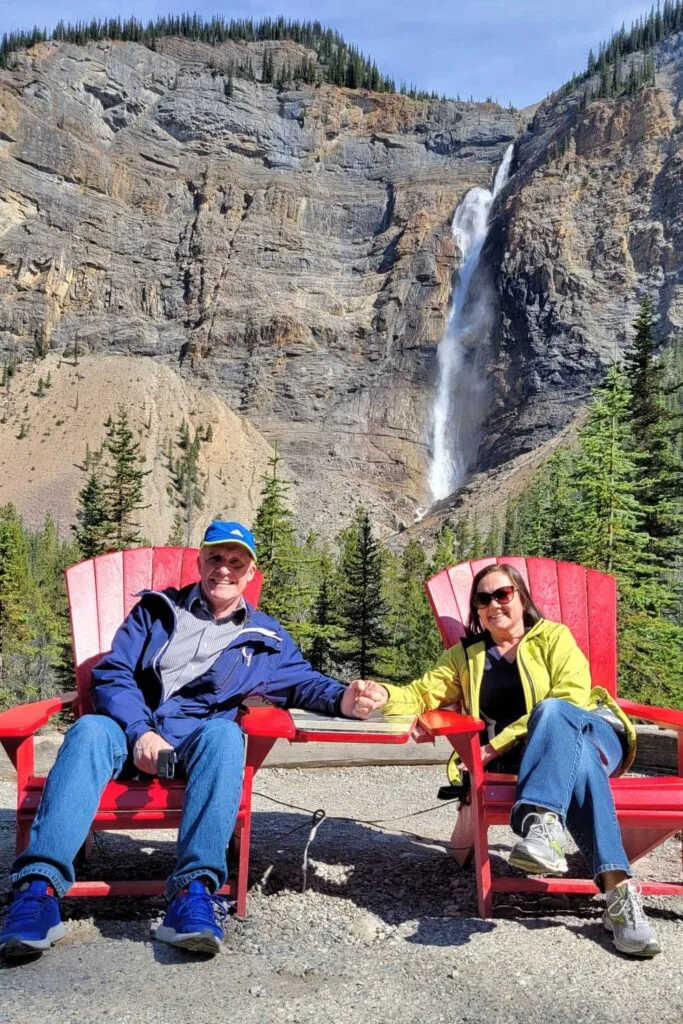
With barely any incline, the 1.3 km return hike offers a rewarding view of a thunderous waterfall. Due to its short walk and flat terrain, families and dogs populate this easy trail, so don’t expect an uncrowded stroll.
The switchback road to the parking area has some hairpin turns and is not suitable for large RVs or novice drivers. Look for mountain goats and hoary marmots on the ascending drive. From the parking lot, the fantastic falls are seen in the distance thundering to the valley below.
The addition of red Adirondack chairs at the viewpoint offers an opportunity for a selfie. The short trail offers beautiful views of the mountainous area and the river.
At the waterfall, the mist was cold and very wet if the flow is heavy, which made it challenging to get photos. If you’re hiking in a cooler season, I’d recommend a waterproof jacket. Should you get quite close to the falls, be careful of your footing as the spray makes the rocks very slippery.
It’s important to note, that from mid-October onwards, access to the parking lot is often blocked by heavy snowfalls. The road to the falls is closed in winter due to the avalanche hazard. But, if you’re visiting in summer and staying in Lake Louise, Takakkaw Falls is a must-see.
A Walk In The Past
- Difficulty: Moderate | Distance: 3 km round trip
Yoho’s A Walk in the Past trail offers a rich history of the Canadian Pacific Railroad’s (CPR) existence near the “Big Hill.” Part of the trail follows the original CPR grade, which is incredibly steep.
Due to avalanches, derailments, and constant engine repairs, the Canadian Railroad eventually built the famed Spiral Tunnels viewed today. By constructing spiral tunnels inside the mountain, CP Rail reduced the grade from almost 4.5 percent to 2.2 percent.
Once the Spiral Tunnels were complete in 1909, it now takes half as many engines to pull a train up the hill. Visitors to Yoho National Park can view the tunnels but wait for a train to experience the real delight.
It’s fascinating to watch a train going one way into a tunnel and the other end driving in the opposite direction. At the end of the trailhead, an 1880s locomotive lies abandoned as a historical reminder of the treacherous “Big Hill.”
During the construction of the tunnels, the railway used narrow-gauge engines to haul away rocks removed from the mountain. Walking this trail to an abandoned locomotive reminded me of my hike to a train wreck in Whistler.
Leanchoil Hoodoos
- Difficulty: Moderate to hard | Distance: 5.2 km round trip
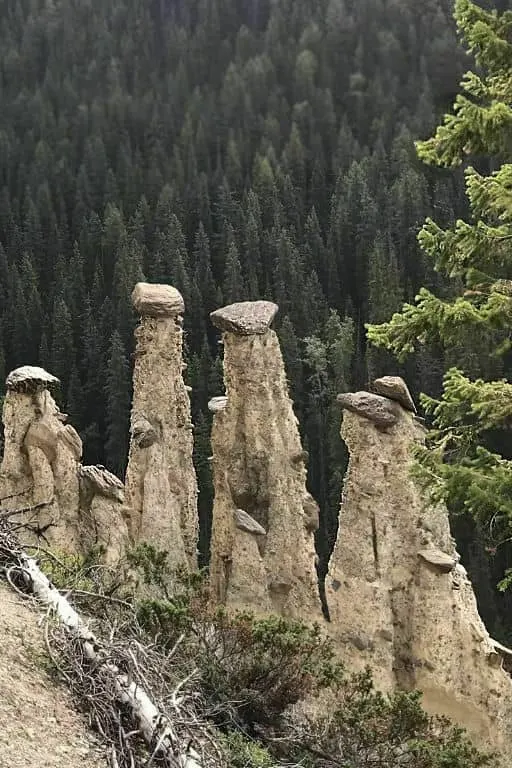
After hiking to the Hoodoos in Banff National Park, I had to see Yoho’s version. While a little challenging, the trail offers two vantage points of the mysterious Hoodoos; one from below and the alternative, at eye level.
The tall pillar structures are uncommon in the Rockies due to changeable weather. They are formed when softer sedimentary earth wears away beneath a harder stone.
To see the Hoodoos, take the old gravel road from the Hoodoo Creek Campground and cross over Hoodoo Creek. Then, the hike ascends quite steeply through the forest, offering beautiful views of the valley and mountains behind you.
After a significant climb, a fork in the trail provides the options for vantage points. The left route continues to climb for close views of the Hoodoos.
While this section of the trail is steep, it rewards the hiker with a welcome bench and the best views. Alternatively, going right descends to the river near the bottom of the natural wonder.
Each path gives a different perspective of the tall pillars with hats made of stone. So, I’d recommend hiking both routes to enjoy the splendor of the unusual rock formations.
Lake O’Hara
- Difficulty: Easy | Distance: 11 km one way
Lake O’Hara has become one of those sought-after places to visit because the area provides a hub for a bunch of back-country trails. While hikers can access the lake by way of a shuttle bus, getting a ticket is a tightly controlled lottery system.
Due to the limited access to the best hiking trails in Yoho National park, the area remains void of tourists. To guarantee a visit to Lake O’Hara, leave the car at the parking lot 15 minutes east of Lake Louise and walk the gravel road instead.
While the route has a 400-meter elevation gain, the grade isn’t noticeable and takes 2.5 – 3 hours. The disadvantage of this hike is that it follows a gravel roadway, which makes for an uninteresting trek. July and August are the best months to hike as snow often covers parts of the trail outside of these dates.
At the end of the road, the beautiful glacial lake rewards the hiker. Set into a sub-alpine valley and surrounded by epic mountains, the turquoise waters are breathtaking.
Should you have the time before the return route, consider walking the 3 km loop trail around the lake. The easy, flat trail offers different perspectives of the lake and the surrounding mountainside.
Should the shuttle have empty spots on its return, you may be able to purchase a ticket instead of hiking back.
Wapta Falls
- Difficulty: Easy | Distance: 4.6 km round trip
Like Takakkaw Falls, Wapta Falls attracts visitors to its impressive waterfall for easy access with little elevation gain. The trail starts with a gravel pathway from the parking area, and the gentle hike continues through a dense forest.
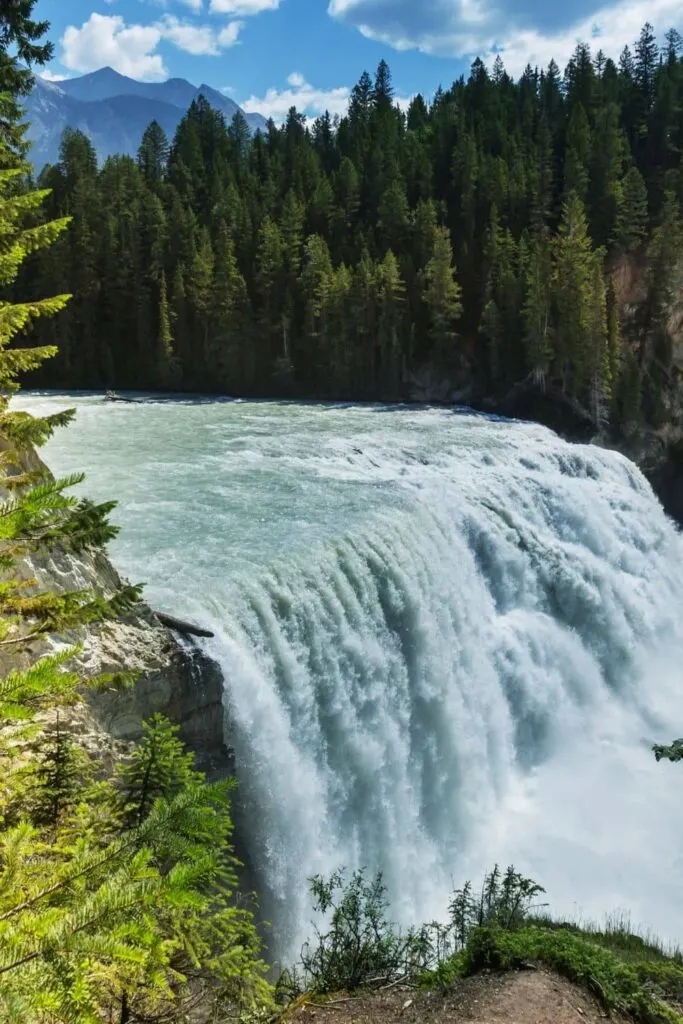
Exiting the evergreen forested area, I walked down to the falls, which were thundering over a broad channel on the Kicking Horse River. While only 30 meters wide, its grandness comes from its expansive width of 150 meters.
It reminded me a bit of my visit to Niagara Falls, wide with a short drop and lots of volume. It did not surprise me it earned the nickname “little Niagara.” The views are striking at the lookout above the falls, but the outlook from the falls’ base is equally jaw-dropping.
Should you venture to the foot of the falls, hikers often see rainbows from the torrent of water flow. Getting to the fall’s base required a hike down a steep trail, so I recommend good gripping shoes.
Unless you’re prepared to get soaked, bring a waterproof jacket so you can enjoy the expansive river bed while listening to the roaring waterfall.
This walk through the forest was relatively easy and family-friendly. As the widest waterfall on the Kicking Horse River, the short hike there does not disappoint.
Hamilton Falls
- Difficulty: Easy | Distance: 1.6 km round trip
Typical of Yoho National Park, the hike to Hamilton Falls meanders through a lush evergreen forest. Unlike some of the other spectacular falls like Wapta and Takakkaw, I found this unusual due to its formation.
While most guides describe this trail as easy, it does have some switchback sections leading away from the river. The water flow varies depending on the time of year, with the optimal viewing times in June to July.
At the falls, its formation is strange, with its water falling between a crack in the limestone wall. At its base, an artificial dam once used to collect water for Emerald Lake Lodge distracts from the beauty of the natural surroundings.
Emerald Lake Loop
- Difficulty: Easy | Distance: 5.2 km round trip
Yoho’s largest body of water, Emerald Lake, gets its name from the color of its water. While frozen in winter, the spring thaw allows its blue-green tones to radiate, created by the large amounts of glacial flour in its lake bed.
Next to the lake, the Emerald Lake Lodge is a great place to stay if you want to explore the many surrounding trails. Its cabin-like rooms feature fireplaces and balconies with a view.
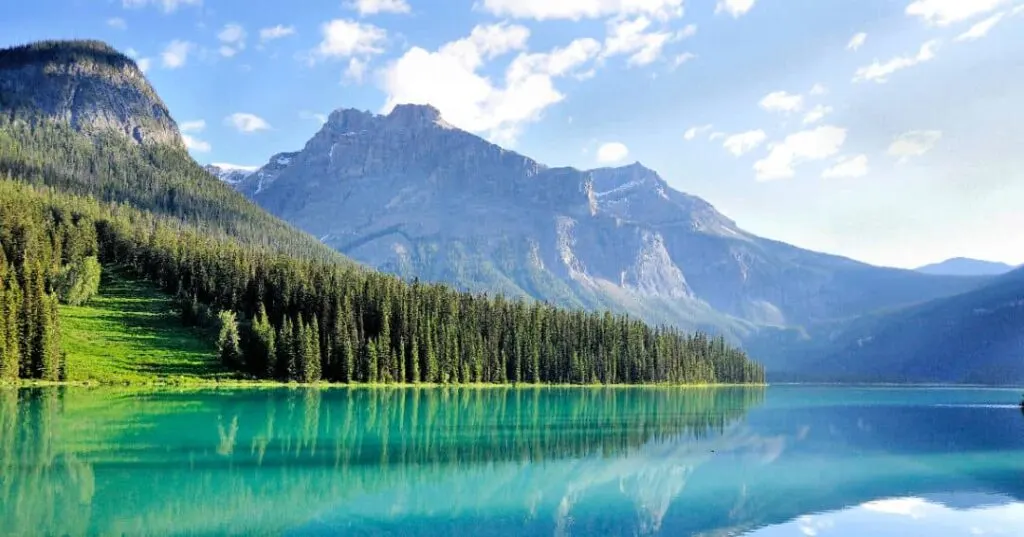
The gentle trail encompassing the lake provides the perfect hike for those wanting a less strenuous hike. In fact, it’s Yoho National Park’s most accessible hike as part of the pathway is wheelchair friendly. Walking the lakeshore trail, look for bald eagles, loons, and other waterfowl.
Unlike most other lakes in the Rockies, this one has contrasting sides. A rocky outlook with evidence of an old avalanche comprises the western side, while the eastern trail wanders through a lush forest of hemlock and cedar trees.
It’s a prime example that the Rocky Mountains can sustain many different types of ecosystems. While the blue waters of Emerald Lake look enticing, bring your “polar bear” spirit because the frigid waters are not for the faint of heart.
Centennial Trail
- Difficulty: Easy | Distance: 2.5 km round trip
As the name suggests, the 1985 Centennial Trail commemorates the park’s centennial. From the Kicking Horse Campground, head west 100 meters to the start of the trail. The shady path follows the Kicking Horse River northwards. In late spring, a colorful display of wildflowers welcomes Yoho hikers.
As you walk the trail, look for mountain goats on the surrounding cliffs. On the other side of the valley, the presence of mining remains on Mount Stephens and Mount Field. Miners extracted silver, lead, and zinc from these hills until 1952 when the mines were closed and shafts sealed.
Where the trail meets the road, turn right, and return to the campground.
Sherbrooke Lake
- Difficulty: Easy | Distance: 5.1 km round trip
The hike to Sherbrooke Lake might be off the beaten path but provides a nice outing away from the crowds. From Field, travel east 11 km to the Great Divide Lodge. It’s important to note there are no public toilets in this parking lot.
With a starting point to the left of the lodge, the trail ascends 190 meters into a subalpine forest. Halfway through the hike, turn left at the fork and continue through the thick forest. After an hour of hiking, the picturesque lake comes into view and is often surrounded by wildflowers.
Nestled between Paget Peak and Mt. Ogden, Sherbrooke Lake exudes a beautiful shade of turquoise, common in the Rocky Mountains. Beyond the lake, it’s another 15 minutes to reach a beautiful waterfall.
Beyond Hiking In Yoho National Park
Although Yoho National Park offers hundreds of hiking trails to appease the summer traveler, it also has some roadside stops worthy of a visit. These include the Natural Bridge, the Spiral Tunnel Lookout, and the Great Divide, also known as the Continental Divide.
The Natural Bridge is an unusual rock configuration created by rushing water through layers of different rocks. As the powerful water eroded the softer rock, the harder stone remained, building a natural bridge over the Kicking Horse River.
The Spiral Tunnels are two train tunnel loops burrowed into a mountainside. While the tunnel openings themselves are not impressive, please wait for a train to see the cars looping back on themselves.
As the name suggests, the Great Divide or Continental Divide marks the point where the land separates water flow into two oceans. To the east, water flows to the Atlantic, and the Pacific benefits from the rainfall on the western slopes.
While Yoho National Park has an entry fee of CAD 10.50 a day for adults, CAD 9 for seniors, and CAD 21 for families, the money goes towards maintaining the park.
If you’re spending a week in any of the parks, the yearly fee of CAD 72.25 is more practical. It’s money well spent investing in a Canadian Natural asset that our descendants can enjoy.
Happy travels ~ Karen
